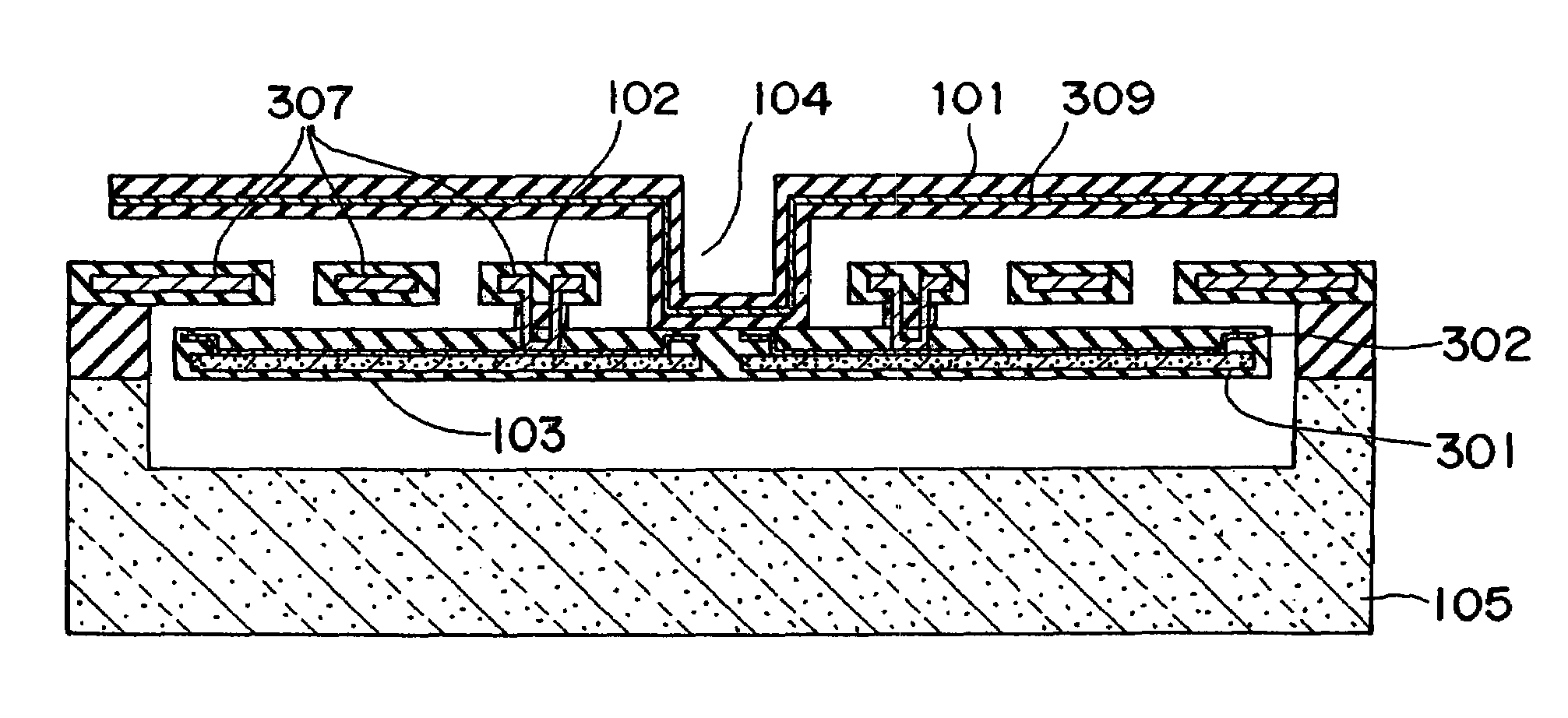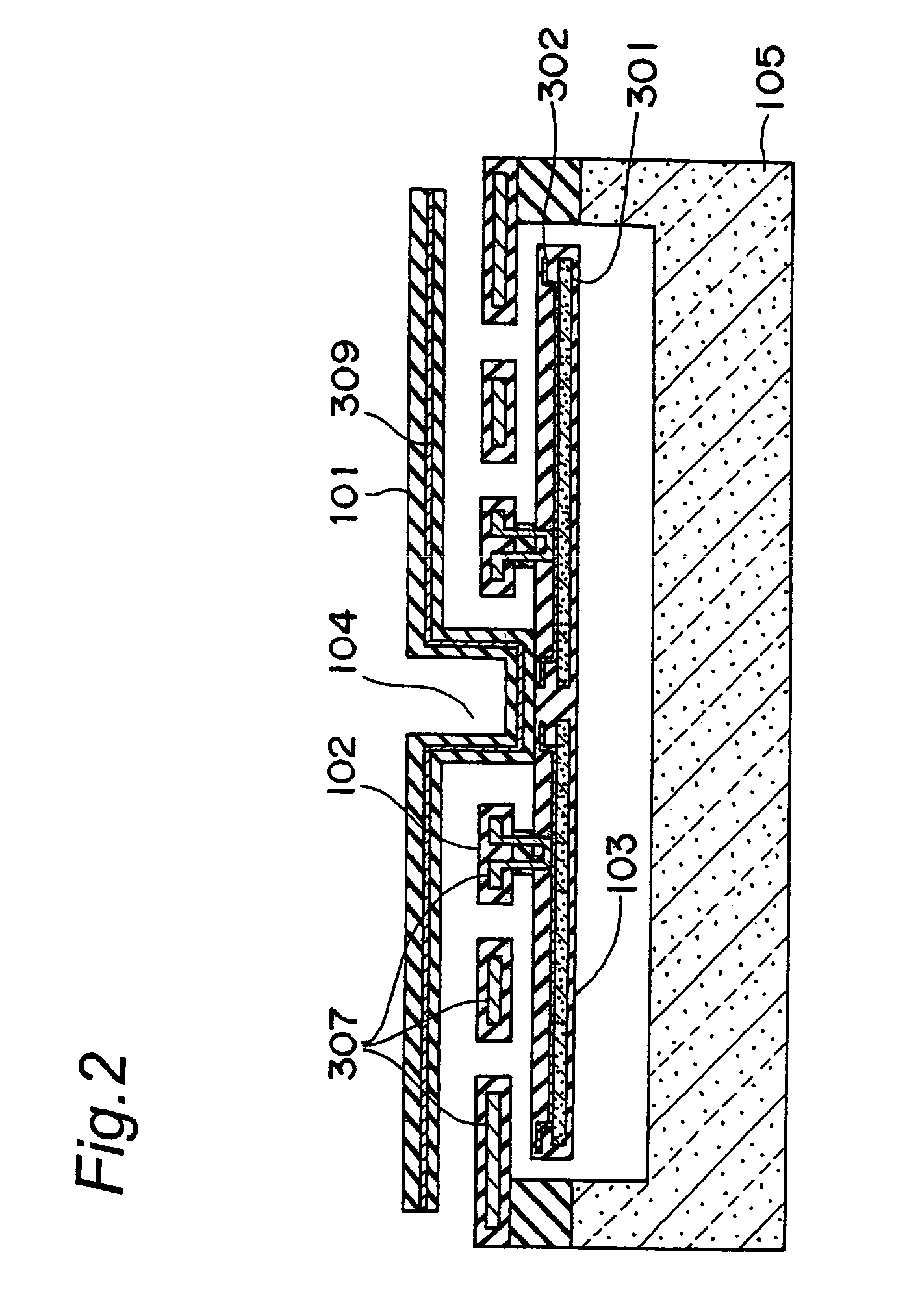Thermal infrared detector and infrared focal plane array
a detector and infrared technology, applied in the field of thermal infrared detectors, can solve the problems of limited size of each infrared detector, complicated device, and high cost of the whole device, and achieve the effect of reducing camera cost and pixel siz
- Summary
- Abstract
- Description
- Claims
- Application Information
AI Technical Summary
Benefits of technology
Problems solved by technology
Method used
Image
Examples
embodiment 1
[0040]FIG. 1 is a perspective view illustrating a thermal type infrared detector according to a first embodiment of the present invention, and FIG. 2 is a schematic cross-sectional view thereof illustrating its cross-section in schematic form. The thermal type infrared detector 10 includes a substrate 105 of mono-crystalline silicon, a temperature sensor 103 which electric characteristics are changed in accordance with changes in temperature caused through infrared absorption, two heat-insulating supporting legs 102 for supporting the temperature sensor 103 in a heat-insulating manner and serving as signal lines for reading out electric signals from the temperature sensor 103, and an infrared absorption portion 101 formed to have thermal contact with the temperature sensor 103 via a supporting pillar 104. A portion of substrate 105 downward of the temperature sensor 103 is removed so as to form a cavity 107 so that the temperature sensor 103 is thermally insulated from the substrate...
embodiment 2
[0069]In embodiment 2, p-n junction diodes of vertical arrangement are employed as the temperature sensor 103. The remaining points are identical to those of Embodiment 1.
[0070]FIG. 8 is a plan view of a temperature sensor 103 employing p-n junction diodes of vertical arrangement, and FIG. 9 is a cross-sectional view seen from section A–A′ in FIG. 8. Similar to Embodiment 1, six p-n junction diodes 301(1) to 301. (6) (hereinafter generally referred to as “diodes 301”) are arranged in two rows, by threes on each side. The respective p-n junction diodes 301 are serially connected by using seven wiring electrodes 302(1) to 302(7) (hereinafter generally referred to as “wiring electrodes 302”). The fourth wiring electrode 302(4) is arranged in a crank-like manner that crosses the center of the rectangular detector for connecting the last diode 301(3) in the first row with the first diode 301(4) in the second row. The first wiring electrode 302(1) and the last wiring electrode 302(7) are ...
embodiment 3
[0072]In embodiment 3, Schottky diodes are used as the temperature sensor 103. The remaining points are identical to those of Embodiments 1 or 2.
[0073]FIG. 10 illustrates a cross-sectional view of the temperature sensor employing Schottky diodes. The arrangement of FIG. 10 corresponds to the p-n junction diodes as explained with reference to FIG. 9 in which the p-type regions 305 are not formed (in which no p-n junction is present). In the arrangement as illustrated in FIG. 10, upon suitably selecting a dopant density for an n-type silicon layer 801 and a material for the wiring electrodes 302 from among metal or metallic silicide, it is possible to form Schottky diodes on an interface between the n-type silicon layer 801 and the wiring electrodes 302. When a plurality of n-type silicon layers 801 are serially connected to the wiring electrodes 302, two interfaces 802 and 803 will be formed between the respective n-type silicon layers 801 and the wiring electrodes 302, each of which...
PUM
 Login to View More
Login to View More Abstract
Description
Claims
Application Information
 Login to View More
Login to View More - R&D
- Intellectual Property
- Life Sciences
- Materials
- Tech Scout
- Unparalleled Data Quality
- Higher Quality Content
- 60% Fewer Hallucinations
Browse by: Latest US Patents, China's latest patents, Technical Efficacy Thesaurus, Application Domain, Technology Topic, Popular Technical Reports.
© 2025 PatSnap. All rights reserved.Legal|Privacy policy|Modern Slavery Act Transparency Statement|Sitemap|About US| Contact US: help@patsnap.com



